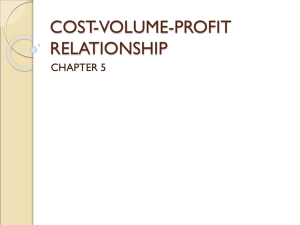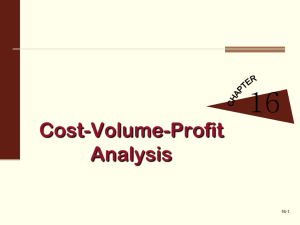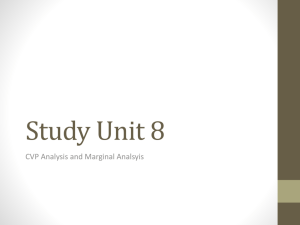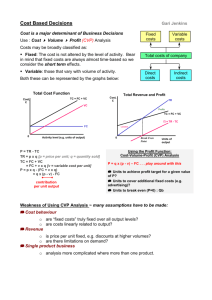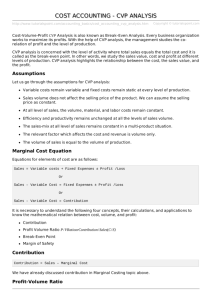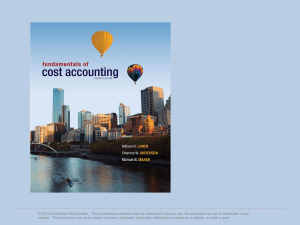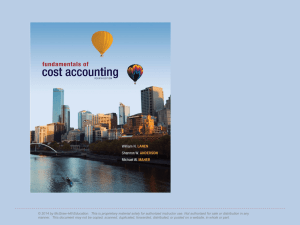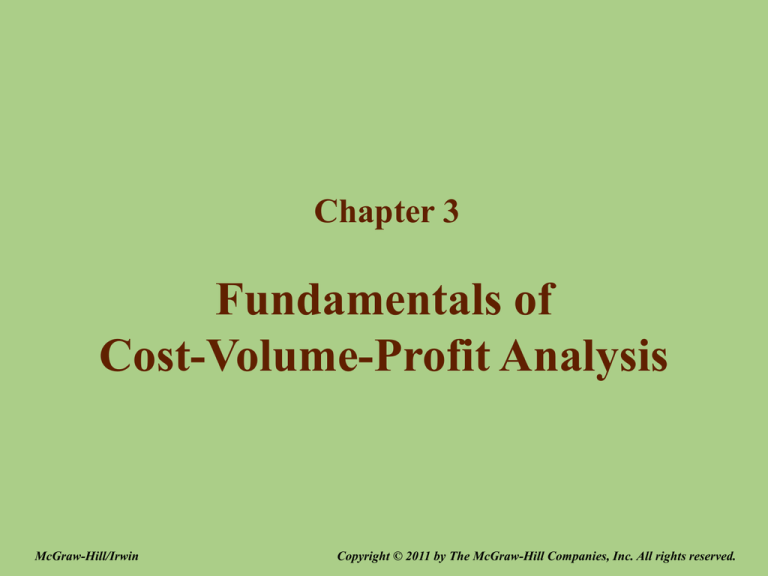
Chapter 3
Fundamentals of
Cost-Volume-Profit Analysis
McGraw-Hill/Irwin
Copyright © 2011 by The McGraw-Hill Companies, Inc. All rights reserved.
Cost-Volume-Profit Analysis
L.O. 1 Use cost-volume-profit (CVP) analysis
to analyze decisions.
• CVP analysis explores the relationship between
revenue, cost, and volume and their effect on profits.
3-2
LO1
Profit Equation
The Income Statement
Total revenues
– Total costs
= Operating profit
The Income Statement written horizontally
Operating profit = Total revenues – Total costs
Profit
=
TR
–
TC
3-3
LO1
Contribution Margin
• This is the difference between price and variable cost.
• It is what is leftover to cover fixed costs and then add
to operating profit.
Contribution margin = Price per unit – Variable cost per unit
P–V
3-4
LO1
CVP Summary: Break-Even
Break-even volume
=
(units)
Fixed costs
Unit contribution margin
Break-even volume
Fixed costs
=
(sales dollars)
Contribution margin ratio
3-5
LO1
CVP Summary: Target Volume
Target volume
=
(units)
Target volume
=
(sales dollars)
Fixed costs + Target profit
Unit contribution margin
Fixed costs + Target profit
Contribution margin ratio
3-6
Use of CVP to Analyze the Effect
of Different Cost Structures
L.O. 2 Understand the effect of cost structure on decisions.
Cost structure:
The proportion of fixed and
variable costs to total costs.
Operating leverage:
The extent to which the cost structure
is comprised of fixed costs.
3-7
LO2
Margin of Safety
• The excess of projected or actual sales
volume over break-even volume
• The excess of projected or actual sales
revenue over break-even revenue
• Suppose U-Develop sells 8,000 prints.
• At a break-even volume of 6,250, its
margin of safety is:
Sales – Break-even = 8,000 – 6,250 = 1,750 prints
3-8
CVP Analysis with Spreadsheets
L.O. 3 Use Microsoft Excel to perform CVP analysis.
• A spreadsheet program is ideally suited to performing CPV routinely.
1. Choose “Tools: Goal Seek…” from the
menu bar.
U-Develop
Price
$0.60
2. In the “Set cell” edit field, enter the cell
address for the target profit calculation.
Variable cost
$0.36
3. In the “To value” edit field, enter the
target profit.
Volume
4. In the “By changing cell” edit field, enter
the cell address of the volume variable.
Price
$0.60
Variable cost
$0.36
5. Click “OK” and the program will find the
break-even volume.
Fixed cost
$1,500
Profit
($300)
5,000
U-Develop
Fixed cost
$1,500
Profit
$0.00
Volume
6,250
3-9
Extensions of the CVP Model:
Income Taxes
L.O. 4 Incorporate taxes, multiple products, and
alternative cost structures into the CVP analysis.
• The owners of U-Develop want to generate
after-tax operating profits of $1,800.
• The tax rate is 25%.
• What is the target operating profit?
Target operating profit = TOP ÷ (1 – Tax rate)
TOP = $1,800 ÷ (1 – 0.25) = $2,400
3 - 10
LO4
Extensions of the CVP Model:
Multiproduct Analysis
• Management expects to sell 9 prints at $.60
each for every enlargement it sells at $1.00.
Selling price
Less: Variable cost
Contribution margin
Prints
Enlargements
$0.60
.36
$0.24
$1.00
.56
$0.44
• Total fixed costs = $1,820
3 - 11
LO4
Extensions of the CVP Model:
Multiproduct Analysis
• What is the contribution margin of the mix?
(9 × $0.24) + (1 × $0.44) = $2.16 + $0.44 = $2.60
• What is the weighted-average contribution
margin of the mix?
(.90 × $0.24) + (.10 × $0.44) = $0.26
• What is the breakeven of the mix?
3 - 12
LO4
Extensions of the CVP Model:
Multiproduct Analysis
7000 × 90% =
7000 × 10% =
Total units
=
6,300 prints
700 enlargements
7,000
$1,820 fixed costs ÷ $0.26 = 7,000 units
3 - 13
LO4
Extensions of the CVP Model:
Alternative Cost Structures
• Given: Fixed costs of $1,500 are sufficient for monthly
volumes less than or equal to 5,000 prints.
For every additional 5,000 prints U-Develop must rent
a machine for $480 per month.
• Original break-even was 6,250 units.
($0.24 x 6,250) – ($1,500 + $480) = ($480)
3 - 14
LO4
Extensions of the CVP Model:
Alternative Cost Structures
• What is the break-even using new fixed cost
containing the rental of the additional machine?
Break-even units = ($1,500 + $480) ÷ $0.24 = 8,250
3 - 15
Assumptions and Limitations
of CVP Analysis
L.O. 5 Understand the assumptions and
limitations of CVP analysis.
• Although the CVP model is a very strong tool,
the output is dependent upon the assumptions
made by cost analysts.
• These assumptions include which costs are
fixed and which are variable.
3 - 16
End of Chapter 3
McGraw-Hill/Irwin
Copyright © 2011 by The McGraw-Hill Companies, Inc. All rights reserved.


